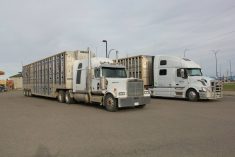AIRDRIE, Alta. – Size matters when it comes to efficient cows.
A smaller cow is often more productive because it eats less than its larger herd mates and is likely to wean a good- sized calf, said Cargill beef consultant Bryan McMurry.
“Fat cows may be pretty, but they don’t put any of that energy into milk,” he said at a recent Foothills Forage Association grazing seminar in Airdrie.
A big cow is unlikely to produce a big, profitable calf because of the energy costs required to get it to that point.
Read Also

Petition launched over grazing lease controversy
Battle continues between the need for generation of tax revenue from irrigation and the preservation of native grasslands in southern Alberta rural municipality.
“From an energy utilization standpoint, a smaller cow is more efficient,” McMurry said.
Research shows that a moderate-sized cow can wean a calf in the 600 lb. range as easily as the 1,500 lb. dam.
His research shows 68 percent of cows in the United States weigh about 1,350 pounds, but 16 percent are bigger than 1,550 lb. and often do not wean a bigger calf than lighter ones.
“In the United States, that is five million cows that weigh over 1,550,” he said.
Adapt to cold
Due to the colder climate, the average Canadian cow is about 1,400 lb. Ruminants and ungulates grow larger farther north because bigger animals can more easily withstand the cold.
Maintenance is higher when cows exceed 1,550 lb., and if a drought or other extreme event occurs, they may not survive it.
“She just can’t hustle enough groceries to keep up,” McMurry said.
“I don’t care if she is packing genetics for growth with yearling weight, rate of gain. If she can’t get the groceries to turn into milk and feed a calf, she is not paying her way.”
A cow weighing 1,100 lb. needs 24 lb. of dry matter per day. Those weighing 1,500 lb. need 30 lb.
The feed difference between the two over the year is 1,600 lb. of dry matter to fill up the larger animal.
A 1,400 lb. cow’s needs may vary from 27 to 31 lb. of dry matter depending on quality. Nutrient requirements peak at lactation, and the 1,400 lb. animal will need 9.5 percent protein in the diet at that time. Protein requirements can drop to nearly six percent of the ration.
Producers selecting replacements often go for the big heifers that may not be the best choice because they will continue to grow and demand more feed.
McMurry advised cutting off the extremes when selecting. Get rid of the undersized and oversized ones as a way to build a moderate-sized cow herd.
He also favours a two-way cross among cows to keep them at a moderate size with the ability to wean a big steer.















